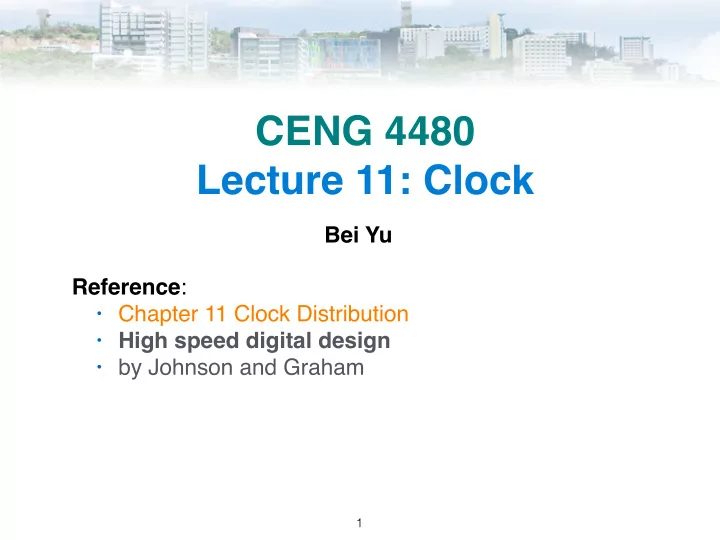

CENG 4480 Lecture 11: Clock Bei Yu Reference : • Chapter 11 Clock Distribution • High speed digital design • by Johnson and Graham 1
A 2-bit ring counter example • 2-bit ring counter • Initially A = B = 0; A = 0011001100 • What is B? A B D1 Q1 D2 Q2 CLK1 CLK2 CLK CENG4480 L11. Clock 2
A 2-bit ring counter example • The result is Okay when clock is slow • But, when clock is TOO fast, get some problem output pattern: 0011001100.. output pattern: 0110011001.. D1 Q1 D2 Q2 CLK1 CLK2 CLK CENG4480 L11. Clock 3
Setup Time and Time Margin • Setup Time: The time that the input data must be stable before the clock transition of the system occurs • Time Margin: measures the slack , or excess time, remaining in each clock cycle ✦ Protects your circuit against signal cross-talk, miscalculation of logic delays, and later minor changes in the layout ✦ Depends on both time delay of logic paths and clock interval CENG4480 L11. Clock 4
Notations in Clock Skew Calculation • T ff : delay of flip-flop (FF) • T G : delay of gate G, including track delay • T setup : worst-case setup time required by FF2, data at D2 must arrive at least T setup before CLK 2 • T CLK : clock period; interval between clocks D1 Q1 D2 Q2 CLK1 CLK2 CENG4480 L11. Clock 5
D1 Q1 D2 Q2 May cause problem if CLK1 CLK2 T CLK is too small CLK T ff T CLK T G T setup CENG4480 L11. Clock 6
EX. B2-1 • CLK1 = CLK2 = 20MHz; T ff = 8ns; T setup = 5ns; T G = 10ns. • Questions : ✦ Find time margin ✦ How many delay G gates can you insert between A and B without creating error? A B D1 Q1 D2 Q2 CLK1 CLK2 CLK CENG4480 L11. Clock 7
Clock Skew • The clock does NOT reach FF1, FF2 at the same time CLK0 T c1,max = latest T c1 arrival time CLK1 CLK2 a positive skew = T c1,max - T c2,min delay 1 T c2,min = earliest T c2 arrival time Source CLK0 delay 2 CENG4480 L11. Clock 8
Why Care Clock Skew? Signal arrives must be Signal arrives here no later than valid before next clock T c1,max + T ff + T G T CLK + T c2,min - T setup D1 Q1 D2 Q2 CLK1 CLK2 Latest arrival T c1,max Earliest arrival T c2,min Clock Source CENG4480 L11. Clock 9
Why Care Clock Skew? • T delay = T c1,max + T ff + T G • T clk’ = T CLK + T c2,min - T setup • Since T delay < T clk’ => T CLk > T ff + T setup + T G + T c1,max - T c2,min { { Constant Logic Skew Delay Delay Impact CENG4480 L11. Clock 10
EX. B2-2 Question: Given • T ff = 7ns; • T G = 5ns; • T setup = 4ns; • T CL = 40MHZ; What’s the biggest time skew allowed? Answer: CENG4480 L11. Clock 11
Strategies to reduce clock skew • Drive them from the same source & balance the delays • Style 1: Spider-leg distribution network ✦ use a power driver to drive N outputs. ✦ Use load (R) termination to reduce reflection if the traces are long (distributed circuit). Total load =R/N. ✦ Two or more driver outputs in parallel may be needed. • Style 2: Clock distribution tree CENG4480 L11. Clock 12
Style 1: Spider-leg Clock CENG4480 L11. Clock 13
Style 2: Clock Tree CENG4480 L11. Clock 14
Modern Clock Design — 1 [Ho et al, ISPD’2009] CENG4480 L11. Clock 15
Modern Clock Design — 2 [Yeh et al, ISQED’2006] CENG4480 L11. Clock 16
Modern Clock Design — 3 [Seok et al, ISLPED’2010] CENG4480 L11. Clock 17
Clock Skew Distribution [Pham et al, JSSC’2006] CENG4480 L11. Clock 18
EX. Skew Optimization • Instead of Zero-Skew, take advantage of Skew. • Question: Given T G =6ns, T ff =10ns, T setup =2ns, what’s the minimal T CLK ? Assume T c3 = 0. FF FF FF T c1 T c2 T c3 CENG4480 L11. Clock 19
Thank You CENG4480 L11. Clock 20
Recommend
More recommend